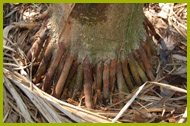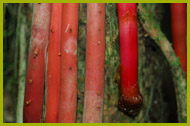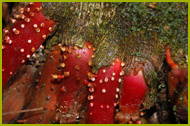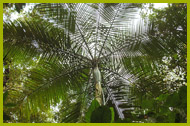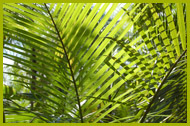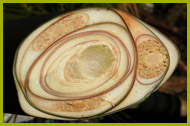|
|
Visible at the base of the trunk is a cone of brown to red coloured roots. These, like the roots of palms in general, consist of a dense tangle of units with the approximately same thickness. If a root is badly damaged, it dies and is gradually replaced by a new one.
|
|
At the young plant leaves are arranged like a fan or palmate. In adulthood, the crown is formed by a bunch of alternating, pinnate, curved leaves 8 to 15 in number. Sheath 0.8 to 1.5 m in length, olive green to dark green, sometimes reddish or orange-tinged, glabrous or with reddish-brown scales (HENDERSON 2000). Depending on the variety, the dark green leaves detach themselves easily from the plant. The petiole is 13 to 54 cm long and densely to moderately covered with dark flat scales (brown, reddish-brown or black). Each leaf has 65 to 72 pairs of long and slender units (LORENZI et al. 2004), arranged in the same plane, being horizontal or hanging, bright, regularly distributed along the central axis (rachis). The rachis, 1.5-3 m long, is covered with few to many scales like those of the petiole. Plants of E. edulis in the same population, ranging from individuals with purple to individuals with green crown colour, are variations in pigmentation (anthocyanins) of the leaf sheaths.
|

